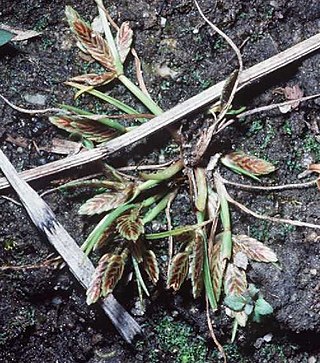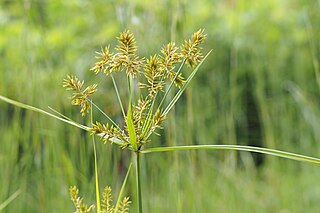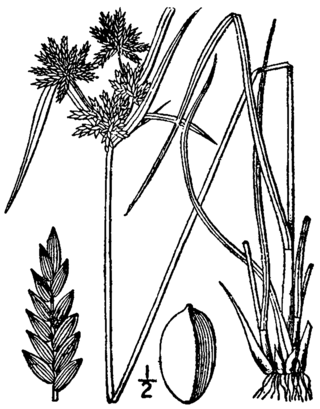
Cyperus is a large genus of about 700 species of sedges, distributed throughout all continents in both tropical and temperate regions.

Cyperus eragrostis is a species of sedge known by several common names, including tall flatsedge, nutgrass, tall nutgrass, umbrella sedge, chufa, Earth almond, zula nuts, edible galingale and pale galingale.

Cyperus bipartitus, commonly known as slender flatsedge, river cyperus, or the shining flatsedge, is a common species of sedge. The name "slender flatsedge" also applies to Cyperus gracilis.

Cyperus fuscus is a species of sedge known by the common name brown galingale, or brown flatsedge. This plant is native to much of Europe, Asia and North Africa from England, Portugal and Morocco east to China and Thailand. It is an introduced species in North America, where it is naturalized in widely scattered locations in the United States and Canada.

Cyperus squarrosus is a species of sedge known by several common names, including bearded flatsedge and awned flatsedge. It is found in wet environments in North and South America, Africa, Australia, southern Asia and Italy.
Cyperus retroflexus is a perennial species of sedge, commonly known as oneflower flatsedge.
Cyperus cuspidatus, commonly known as the coastal plain flatsedge, is a sedge of the family Cyperaceae that is native to seasonally dry tropical areas of Africa, Asia, the Americas and Australia.

Cyperus flavescens, commonly known as the yellow flatsedge, is a species of flowering plant belonging to the family Cyperaceae.

Cyperus microiria, commonly known as the Asian flatsedge, is a species of sedge from Asia It is found from the Himalayas to Japan.
Cyperus manimae, commonly known as the smoothstem flatsedge or the spectacular flatsedge, is a species of sedge that is native to an area of southern North America, Central America, and northern South America.
Cyperus amabilis, commonly known as the foothill flatsedge, is a species of sedge that is native to tropical and sub-tropical areas in the Americas, Africa and Asia.
Cyperus croceus, commonly known as Baldwin's flatsedge, is a species of sedge that is native to parts of North America, Central America, and South America.
Cyperus auriculatus, commonly known as the eared flatsedge, is a species of sedge that is native to some islands of Hawaii.

Cyperus grayi, commonly known as Gray's flatsedge, is a species of sedge that is native to south eastern parts of the United States.

Cyperus hermaphroditus, commonly known as the hermaphrodite flatsedge, is a species of sedge that is native to parts of southern parts of North America, Central America and northern parts of South America.

Cyperus houghtonii, commonly known as Houghton's flatsedge, is a species of sedge that is native to parts of North America.
Cyperus imbricatus, also known as the shingle flatsedge, is a species of sedge that is native to sub-tropical and tropical areas of the world.
Cyperus planifolius, commonly known as flatleaf flatsedge, is a species of sedge that is native to southern parts of North America, Central America, the Caribbean, and northern parts of South America.
Cyperus radians is a species of sedge that is native to eastern parts of Asia.









